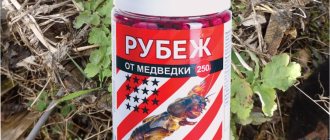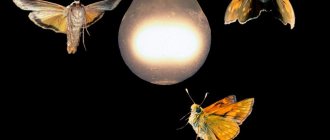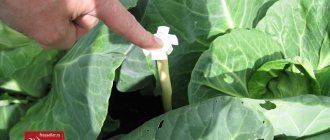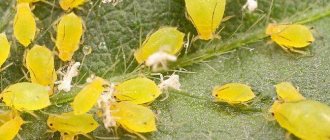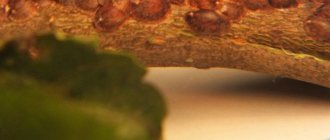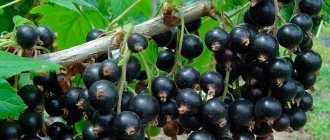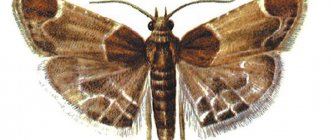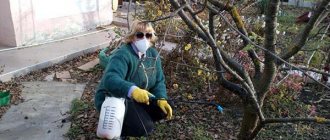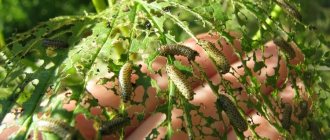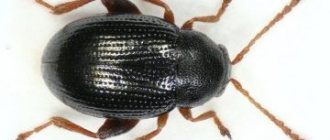It’s not just you who is laying claim to the beautiful cabbage sprawled freely in the garden bed. Various pests are lurking, waiting for the right moment to take over the harvest into which so much time and effort has been invested. The article will help you recognize enemies by sight from the photos provided and will tell you about methods of combating the main types of cabbage aggressors.
Cabbage aphid
Damages cabbage, radish, radish, mustard, rapeseed. Lives on weeds: rapeseed, shepherd's purse, wild radish. In the south of the country it is considered a dangerous pest.
The body of the wingless female is ovoid, covered with whitish waxy pollen, its length is 1.9-2.3 mm. Aphid eggs are black, shiny, elongated oval, 0.5 mm long.
Winged females have a yellowish-green abdomen and brown head and thorax.
During the year, aphids produce up to 16 generations. Eggs overwinter on stumps left in the garden unharvested or stored until spring for planting for seeds. The eggs also overwinter on weedy cruciferous plants. In the spring, the eggs hatch into larvae. They feed on weeds, sucking the juice. After 10-12 days, the larvae turn into wingless females (founders). Each female gives birth to up to 40 larvae, forming colonies of aphids on the weeds. Later, winged aphids (spreaders) appear among the aphids, which fly from the weeds to cabbage, radishes, and radishes, where they multiply, giving birth to larvae. This is how new colonies of aphids appear on cabbage. The number of aphids grows quickly; they often completely cover the leaves, and even the shoots on the seeds. In autumn, sexual individuals appear in aphid colonies - males and females. After mating, females lay 2-4 eggs on stumps, cabbage leaves, and weeds. After this, the females die, and the eggs remain to overwinter.
Aphids and their larvae pierce plant tissue with their proboscis and feed on their sap. Damaged leaves turn yellow, become deformed, and the growth of the head stops. On damaged testes, seed yield is reduced.
Colonies of aphids attract parasites and predators: ladybugs, syrphid flies, lacewings, and wasps. They significantly reduce the number of aphids.
Control measures. Collecting stumps in the fall and burning them. Destruction of weeds from the cruciferous family: cress, wild radish, shepherd's purse. Spraying cabbage before tying heads with kinmiks, sumi-alpha or infusions (decoctions) of plants. Placing the seeds away from cabbage plantings.
Chemicals against caterpillars
The problem can be quickly and radically solved with the help of pesticides - after 1-2 hours after treatment, most of the caterpillars will die.
However, the use of chemistry has many side effects :
- not only pests will suffer, but also other living organisms, and the local ecosystem may be disrupted;
- adult individuals are less sensitive to poisons than young larvae, so, most likely, you will have to spray the plants with poison again;
- pesticides can be harmful to humans - it is necessary to adhere to safety rules when processing;
- poisons cannot be used less than a month before harvest.
Chemical treatment is carried out in calm weather using personal protective equipment
When deciding to purchase a chemical pest control product, pay attention to the degree of danger it poses to people, pets and bees. A drug whose packaging says hazard class 1 or 2 should not be used in a summer cottage.
Among the most popular (and least dangerous) chemicals are: Fufanon, Kemifos, Antitlin-P and Grinda.
Biological products such as Bitoxibacillin, Fitoverm, Nemabakt, Lepidotsid, Dendrobacillin and Entobacterin-3 will also help to successfully get rid of caterpillars on cabbage. They contain live bacteria that kill pests. The use of drugs of this type allows you to fight cabbage parasites with minimal negative consequences for humans, pets and beneficial insects.
Rapeseed leaf beetle
Damages rapeseed Rapeseed is a plant of the Brassica family, an annual herbaceous plant. It is noteworthy that..., cabbage, radish, radish. The beetle is ovoid-elongated, up to 10 mm long, reddish-red in color, with a black longitudinal stripe along the seam above the wings.
Leaf beetle eggs overwinter in the top layer of soil. The larvae that hatch in the spring feed on weed leaves and move from them to cultivated cruciferous plants. After 10-15 days, the larvae finish feeding and go into the ground, where they pupate at a depth of 5-8 cm. The pupal stage lasts two weeks. Young beetles emerge from the soil, feed, and with the onset of hot, dry weather they burrow into the ground to a depth of 15-18 cm until September. In autumn, beetles leave the soil and feed on weeds. In October-November, females lay overwintering eggs in the soil.
On cabbage and other cruciferous vegetables, the larvae eat away the pulp of the leaves, leaving the veins and stems intact. The beetles eat the leaves, and the flowers and pods on the seeds.
Control measures. Destruction of weeds, primarily cruciferous plants, on which the leaf beetle feeds in spring and autumn. Manual collection of larvae and beetles is possible.
Slugs
All types of cabbage are the signature dish for the soft-bodied pest. Externally, slugs are similar to a snail. A distinctive feature is the absence of a shell. Therefore, their bodies are covered with a thick layer of mucus, which prevents them from drying out.
The favorite period of hunting in the beds is from dusk to morning. The rest of the time, slugs hide in secluded places. The exception is cool and damp days. You can find out that the harvest hunting season is open by the silver marks on the cabbage and by the numerous holes in its leaves. Now all that remains is to be patient; the battle with slugs will be labor-intensive, troublesome and not without losses on the crop.
Experienced farmers resort to a variety of measures.
- Spraying in the evening with vinegar (a glass of 9% vinegar per bucket of water) or mustard solution (150 g of powder per bucket of water).
- Sprinkling ash, crushed shells or sand around the heads of cabbage.
- Treatment with onion peel infusion. It is poured with boiling water and kept covered for 3-4 hours. Then it is slightly diluted with water to reduce the concentration and the affected cabbage is treated.
- Ammonia with tar soap. For 5 liters of water take 1 tbsp. l. ammonia and soap. Treat vegetables with a solution from a watering can once a week (after regular watering).
- Ulitsid. A highly effective and safe product for people and animals based on iron phosphate.
Some gardeners go hand-to-hand against voracious gastropods:
- Lay the boards on damp soil between the rows. After the meal, the slugs crawl under them for an afternoon nap. That’s when the angry owner of the crop takes the shellfish “lukewarm.”
- They dig containers with treats (beer, kvass, fermented compote or syrup) around the cabbage, and in the morning they collect the tipsy overnight guests.
One of the exotic and desperate measures is to attract natural enemies of slugs (toads, frogs, hedgehogs) to the site.
Cabbage (horseradish) leaf beetle, or babanukha
Beetles and larvae harm cabbage, radishes, radishes, and horseradish.
The beetle is ovoid, convex, dark green in color with a metallic tint, up to 3 mm long. The eggs are oblong-oval, yellow. The larvae are dirty yellow with longitudinal rows of black tubercles and a black head, up to 5.5 mm long.
The beetles overwinter in the soil and under plant debris. In spring, on cultivated and wild cruciferous plants, beetles eat away the pulp of the leaves without touching the veins. The females lay eggs on the leaves in holes gnawed into the leaf. The larvae feed on leaves, skeletonizing them. After two weeks, the larvae go into the soil to pupate.
Control measures. Destruction of weeds in the garden and surrounding areas. Removing plant residues from the garden after harvesting.
What to plant next to cabbage to prevent pests
In the immediate vicinity of the cabbage beds, plants are planted that repel insects with their smell:
- mint and lemon balm;
- sage;
- dill;
- celery;
- rosemary;
- fennel;
- parsley;
- basil;
- cilantro;
- calendula.
Onions and garlic growing next to cabbage beds also repel pests.
In addition to all methods, it is necessary to observe all precautions, weed out weeds, dig up the soil and disinfect it in the fall to obtain a full harvest.
Cruciferous flea beetles
Flea beetles are very dangerous pests of seedlings and young plants of cabbage, radishes, and radishes. Flea beetles are six species of small beetles, up to 3.5 mm long, black or greenish-blue in color. The hind legs of beetles are well developed. Beetles fly and, pushing off with their hind legs, jump.
Beetles overwinter under plant debris, in the soil of vegetable gardens and surrounding areas. In spring they leave their wintering grounds early, at the beginning of April. At first they feed on jarutka, rapeseed, wild radish, and shepherd's purse. With the emergence of radishes, cabbage seedlings and cabbage seedlings, they fly to them. The beetles gnaw out numerous holes on the leaves. If the damage is severe, the seedlings die within two to three days. Sometimes seedlings are destroyed by beetles even in the cotyledon phase. Flea beetles are also dangerous for cabbage seedlings that are planted in the ground but have not yet taken root. The likelihood of plant death from flea beetles increases in dry and hot weather, when plants are depressed and leaf surface growth is slowed down. Damage caused by flea beetles to well-developed seedlings with a large leaf surface is less dangerous.
Female flea beetles (except for the light-footed flea beetle) lay eggs on the soil near food plants. The egg stage lasts from 3 to 12 days. The larvae feed on small roots and do not cause noticeable harm. The larvae pupate in the soil. The new generation of beetles appears at the end of July. They feed on various cruciferous vegetables before the onset of cold weather. They can harm cabbage and late sowing radishes.
The light-footed flea beetle lays eggs on the leaves of radishes, radishes, and wild cruciferous vegetables. Its larvae penetrate into the leaf tissue and make passages (mines) in it. The flea beetle feeds only on horseradish. Its larvae live in the stems or in the main vein of horseradish leaves.
Control measures. Early sowing and planting of cruciferous crops. Measures to accelerate the growth and development of plants (watering, fertilizing, loosening the soil, etc.). Weed control in the garden and surrounding areas. Spraying plants with fury, sumi-alpha or kinmiks preparations. Radishes are sprayed only on seedlings. Spraying (instead of chemicals) with wormwood infusion or pollinating plants with tobacco dust 2-3 times with an interval of 4-5 days.
General information about the dangers of insects
Hordes of pests are very dangerous. Immediately after waking up, they need food. At first they eat weeds and plant debris, but as soon as gardeners plant seedlings of cabbage or other crops, the insects attack young plants.
Some pests damage the roots of cabbage, others feed on the juice by piercing the leaves. The third group, equipped with a powerful mouthparts, eats greens and spoils the heads of cabbage. The danger is that fungal and bacterial infections penetrate into the damage on the leaves and stems. Pathogens cause cabbage diseases that are difficult to treat.
Insects injure the growing points, which ultimately leads to the formation of deformed ovaries or their absence. Plants affected by pests weaken and wither. It is important to learn to recognize the signs of an insect invasion in order to promptly destroy those who eat cabbage in the garden.
Cabbage stem weevil (secretive proboscis)
Damages seedlings, young plants and seeds of cabbage, radishes, radishes.
The beetle is black in color and covered with gray scales. Its body length is 3 mm. The rostrum is long, thin, and bent under the chest. The egg is oval, translucent, 0.7 mm long. The larva is whitish, with a yellow head, legless, up to 5 mm long.
The weevil has a one-year generation. Beetles overwinter under plant debris in the soil. In spring they appear on the soil surface in the second half of April. At the end of April - beginning of May, females begin laying eggs. In the midrib of the leaf from below or (less often) in the petiole and stem, the female gnaws out a deep hole with her proboscis and lays an egg in it. The egg stage lasts 4-5 days. The larvae gnaw through the petiole, penetrate the stem, eating away its core, and often descend to the root collar. On large cabbage leaves, the larvae feed in the petiole and do not go into the stem. Damaged leaves dry out, plant growth slows down, and sometimes seedlings die.
On the seeds of cabbage, radish, radish, the larvae damage the leaves and peduncles; the seed yield decreases, the percentage of puny seeds increases. On cauliflower, larvae can burrow from the stems into the head.
The larvae pupate in the surface layer of soil. The hatched beetles feed on the leaves of cruciferous plants, and with the onset of autumn they go to wintering areas.
Control measures. Destruction of weeds on which beetles feed in the spring. Culling and destruction of infected seedlings during planting. Breaking off and destroying heavily damaged leaves before the larvae emerge. Loosening the soil between the rows during the period of pupation of the larvae (June) and deep digging of the soil in the fall after harvesting.
Spring cabbage fly
Damages cabbage, radishes, radishes, and other cruciferous vegetables.
The fly is similar in appearance to a housefly and reaches a length of 6.5 mm. The color of the male is gray, his pronotum has three dark stripes. The female is ash-gray. The egg is white, elongated, with a longitudinal groove, about 1 mm long. The larva is white, shiny, its anterior end is narrowed. The length of the adult larva is up to 8 mm.
The fly develops in two to three generations per year. The pupae overwinter in the soil at a depth of 10-15 cm. The emergence of flies in the spring coincides with the average time of planting seedlings in the ground. In greenhouses, flies fly out earlier. Females lay eggs on the lower part of the stem, on the root collar, or (most often) on the ground near the plant, one at a time or in small groups. One female lays up to 150 eggs. In hot, dry weather, some of the eggs die. It is noted that egg laying begins when the cherry blossoms.
The egg stage lasts 5-8 days. The larvae penetrate into the roots and into the ground part of the cabbage stem, make tunnels in the roots of radishes and radishes, and in the roots of horseradish. Larvae also develop on rapeseed, wild radish, grasshopper and other weeds. The larvae feed for 20-30 days, after which they go into the soil, where they turn into pupae in a false cocoon. After half a month, flies emerge from the pupae. They lay eggs on cultivated and weed cruciferous plants.
Control measures.
- Growing healthy, well-developed seedlings that can resist fly damage.
- Early planting of seedlings in the ground at an optimal depth (deep planting increases seedling growth).
- Hilling up damaged plants, fertilizing, watering so that the seedlings form additional roots.
- Culling and destruction of severely damaged plants.
- Repelling flies from plants by adding bazodin granules to the soil under seedlings or adding tobacco (shag) dust half mixed with ash or naphthalene mixed (1:1) with sand under the plants. Naphthalene and tobacco dust are sprinkled under the plants when the first eggs appear and repeated 2-3 times with an interval of 7-8 days.
- Destruction of cruciferous weeds.
- Collecting stumps and removing them from the garden immediately after harvesting, before the fly larvae go into the ground.
- Deep digging of the soil in the fall: when cultivating the soil, some of the fly pupae in it die.
Cabbage moth
Damages cabbage, radishes, and other cruciferous vegetables.
The butterfly has a wingspan of 14-17 mm. Its fore wings are narrow, with a brown wavy stripe, its hind wings are narrow, with a long fringe. The eggs are small, oval, flattened, immediately after laying they are yellowish-white in color, then darken. The caterpillars are light green. Their body is narrowed in front and behind, its length is up to 12 mm.
In some years, the moth reproduces in large numbers. Moth pupae overwinter in cobweb cocoons on post-harvest residues and on cruciferous weeds. Butterflies appear at the end of April. They are most active at dusk and at night. Females lay eggs one at a time or in groups of 2-4 eggs on the underside of leaves and on petioles. The fertility of females is up to 300 eggs. The egg develops in 3-7 days. Immediately after hatching, the caterpillars penetrate the leaf and make short passages (mines) in it. The caterpillars live in the leaf for 2-3 days, then they come to the surface of the leaf and gnaw out numerous windows in it with intact transparent skin. Caterpillars are very active when they are worried: they wriggle nervously, curl up in a horseshoe shape and descend to the ground on a web. The caterpillars feed for one and a half to two weeks. Having finished feeding, they weave a web-like cocoon right here on the plant and pupate in it. Over the course of a year, the moth develops in four generations.
Leaves damaged by caterpillars turn yellow and dry out.
Control measures.
- Spraying plants with fury or kinmiks, lepidocide, bitoxibacillin.
- Destruction of weeds on which moths reproduce.
- Destruction of post-harvest residues; moth pupae can overwinter on them.
- Deep digging of the soil in the fall.
Cabbage white (cabbage)
Damages cabbage, radishes, rapeseed Rapeseed is a plant of the Brassica family, an annual herbaceous plant. It is noteworthy that ..., mustard, mignonette, nasturtium.
The wingspan of the butterfly is 55-60 mm. The wings are white. At the top of the fore wings there is a black crescent-shaped spot. The female has two rounded black spots on her forewings. The eggs are yellow, bottle-shaped, with longitudinal ribs. The caterpillar is yellow-green in color, with black spots. There is a yellow stripe along the sides of the caterpillar's body, and a light stripe along the back. The caterpillar has sparse hairs and bristles on its body. Caterpillar length is up to 40 mm.
Cabbage whites develop in 3-4 generations. The pupae overwinter on the trunks of trees, bushes, on fences, and on the walls of buildings. At temperatures of -20°C and below, many wintering pupae die. This explains the low numbers of white moths in the years after a cold winter. Butterflies emerge in April, fly during the day, and feed on nectar on the flowers of various plants.
Butterfly eggs are laid in groups of 15-200 eggs on the underside of leaves of cabbage and other cultivated and weedy cruciferous plants. The egg stage lasts 1-2 weeks. Young caterpillars stick together. They eat the leaf parenchyma from the underside without violating the integrity of the skin (they skeletonize). Damaged leaves turn yellow and dry out. Grown-up caterpillars eat leaves from the edges, often eating leaves entirely, leaving only large veins. The duration of caterpillar development is 2-4 weeks. Caterpillars pupate on fences, walls of buildings, on tree trunks, and on the stems of large weeds. Single caterpillars pupate on cabbage leaves. The number of butterflies of the overwintered generation is usually small, but it increases in subsequent generations.
The number of whitefish during the growing season is reduced by parasites.
How to treat cabbage against pests
If obvious signs of damage to plantings appear, urgent measures should be taken. Protection of cabbage from pests is carried out using folk remedies and special chemicals:
- "Bankol";
- "Fury";
- "Decis";
- "Aktara";
- "Kemif";
- "Iskra-M".
This method is practiced over large areas and with obvious massive signs of damage. Preparations against cabbage pests are used no later than 2 weeks before using vegetables for food.
Advice! Wood ash is a complex fertilizer and pest repellent. It is sprinkled on the ground around the plants and the leaves are dusted.
It is possible to protect cabbage from pests using biological products:
- "Verticillin";
- "Aktofit";
- "Pecilomycin";
- "Metarizin";
- "Nemabakt";
- "Antonem-F".
Metarizin
All biological products are less toxic than chemical compounds. They are used at an air temperature of at least 18-20 degrees. They are easily washed off with water, so treatments should be carried out regularly. Cabbage should be sprayed against pests after the foliage has dried.
Turnip white (turnip)
A butterfly similar to a cabbage white, but smaller in size. On its front wings there are two black spots for the female, one for the male. The lifestyle and nature of the damage are the same as that of the cabbage white, but the caterpillars of the summer generation can penetrate cabbage heads, contaminating them with excrement and causing rot.
Mustard or mignonette
The wingspan of the butterfly is up to 47 mm. Caterpillars eat cabbage leaves; radish, mignonette. On the seeds of cruciferous plants they damage buds, flowers, and pods.
Control measures. Manual collection of caterpillars and clutches of white butterfly eggs from cabbage. Sowing nectar plants to attract parasitic insects. Release of Trichogramma for the purpose of destroying whitefish eggs. Spraying cabbage against caterpillars with Kinmiks, Fury, against young caterpillars - with lepidocide, bitoxibacillin or infusions (decoctions) of mustard, wormwood, pepper. For better adhesion to infusions and decoctions, add paste (1 cup) or skim milk (0.5 cups) per 10 liters of infusion.
Cabbage scoop
Dangerous pest of cabbage. It also damages beets, onions, peas, lettuce, poppy seeds, potatoes, beans and other plants.
The butterfly is brown-gray, with a wingspan reaching 50 mm. The front wings have two dark stripes and two spots of the same color. The eggs are hemispherical in shape, with radial ribs extending from the top. Adult caterpillars are greenish or brownish-brown, with wide yellow stripes on the sides, up to 50 mm long.
The cabbage cutworm develops in two generations per year. The pupae overwinter in the soil at a depth of 10–12 cm.
The flight of butterflies of the wintered generation takes place in the second half of May, of butterflies of the next generation - in August. Butterflies are nocturnal. During the day they sit under leaves, under lumps of soil. The dark color of butterflies makes them inconspicuous.
Females lay eggs on the underside of cabbage leaves in groups of 10 to 100 pieces. The egg stage lasts 5-10 days. The first time after hatching, the caterpillars live together - where the eggs were laid. They feed at night on the leaf parenchyma on its underside. The grown caterpillars crawl around the plant, hiding between the leaves. They gnaw through holes of various sizes and shapes in cabbage leaves. But more serious damage is caused by adult caterpillars. They penetrate the head of cabbage, gnaw long passages in it, and pollute it with excrement. The head of cabbage loses its marketable appearance. A species is an evolutionarily established set of individuals, characterized by a single... The development of caterpillars lasts about a month. Having finished feeding, they go into the soil to pupate.
The number of cutworms is reduced by Trichogramma, tachina flies, and parasitic ichneumon flies.
Control measures. Early planting of seedlings. Good care of plants, ensuring their normal development. Periodically inspect plants and crush caterpillars. Loosening the soil between the rows of cabbage and other crops, which causes the death of caterpillars and pupae in the soil and makes it difficult for butterflies to emerge. Weed control. Digging the soil after harvesting. Release of Trichogramma during the period of mass egg laying by butterflies. Spraying cabbage with Kinmiks against caterpillars before setting a head of cabbage.
Cabbage moth
Damages mainly cabbage, less - other cruciferous vegetables.
The wingspan of the butterfly is 25-26 mm. Its fore wings are dirty yellow, with two oblique brown stripes and a dark spot. The caterpillars are yellowish-green, with a chain of white spots on the back; A yellow stripe runs along the sides of the caterpillar. Caterpillar length is up to 19 mm.
Caterpillars overwinter in the soil. In the second half of May they pupate. Butterflies fly in June - July. The females lay eggs on the underside of leaves of cabbage and other cruciferous plants in small groups. The egg stage lasts 8-10 days. Young caterpillars gnaw holes in the leaves without disturbing the integrity of the skin, while older ones eat through holes in the leaves. A peculiarity of older caterpillars is their tendency to climb inside the budding head of cabbage and damage young leaves there. The fed caterpillars go into the soil to pupate.
Control measures. The main measures in the fight against moth are agrotechnical, ensuring good plant development. Control of weeds on which the moth reproduces. Deep digging of the soil in the fall, changing the usual wintering conditions of the caterpillars. Spraying the plants before setting the head of cabbage with Kinmiks or Fury.
Preventing insect infestations
Despite the abundance of pest control agents, it is much easier to prevent their invasion than to fight it. Experienced gardeners recommend paying attention to preventive measures, these include:
- digging up the site in the fall;
- removal of plant residues from the garden followed by destruction;
- use of fine mesh to protect against insects;
- planting plants near cabbage beds that repel pests - marigolds, calendula, fennel, dill.
If you discover that someone is eating cabbage seedlings, you should not hesitate. There are quite a few methods of pest control, so dealing with insects will not be difficult. Treatment with chemicals is permissible before the formation of ovaries; at other stages of the growing season, preference should be given to biological preparations or folk remedies.
Rapeseed sawfly
Damages cabbage, less often radish, and mustard. Lives on wild cruciferous plants.
The adult sawfly is an insect with two pairs of transparent membranous wings. The sawfly's body is orange-yellow, with black spots on the back, 7-8 mm long. The female has an ovipositor at the top of her abdomen, retracted inward and consisting of four plates, two of which are jagged, like a saw (hence the name “sawfly”). The larva is grayish-green, with a black head, wrinkled, up to 20 mm long, with 11 pairs of legs.
The sawfly reproduces in large numbers, in patches. The larvae overwinter in the soil at a depth of 7-12 cm in a dense, water-impermeable silky cocoon. They pupate in the spring, and adult sawflies emerge from the soil in mid-May. First, they actively feed on the nectar of flowers of plants from the umbelliferous and cruciferous families, then the females begin laying eggs on the lower surface of the leaves. The female cuts through the skin of the leaf with her ovipositor and lays one or several eggs in the wound. The eggs are usually located along the veins.
The larvae eat leaves from the edges, often leaving only rough veins. Having completed development, the larvae go into the soil and pupate there. In July, a new generation of sawflies emerge. Their larvae cause damage in August. The sawfly develops in 2-3 generations.
Control measures. Destruction of cruciferous weeds on which sawfly larvae feed. If the number of larvae is high, spray the cabbage with sumi-alpha or kinmiks before tying the head of cabbage. Deep digging of the soil immediately after harvesting in areas where plants were damaged by sawflies in order to destroy the larvae.
